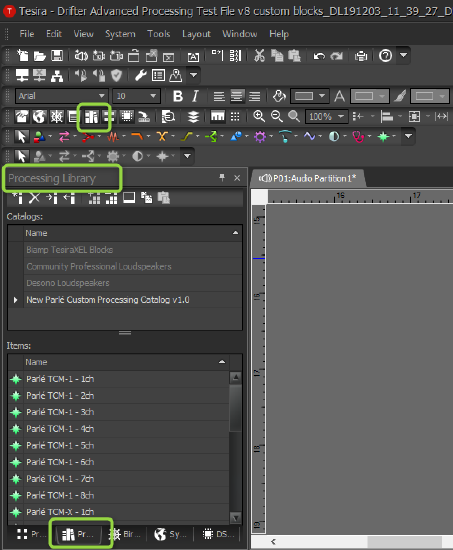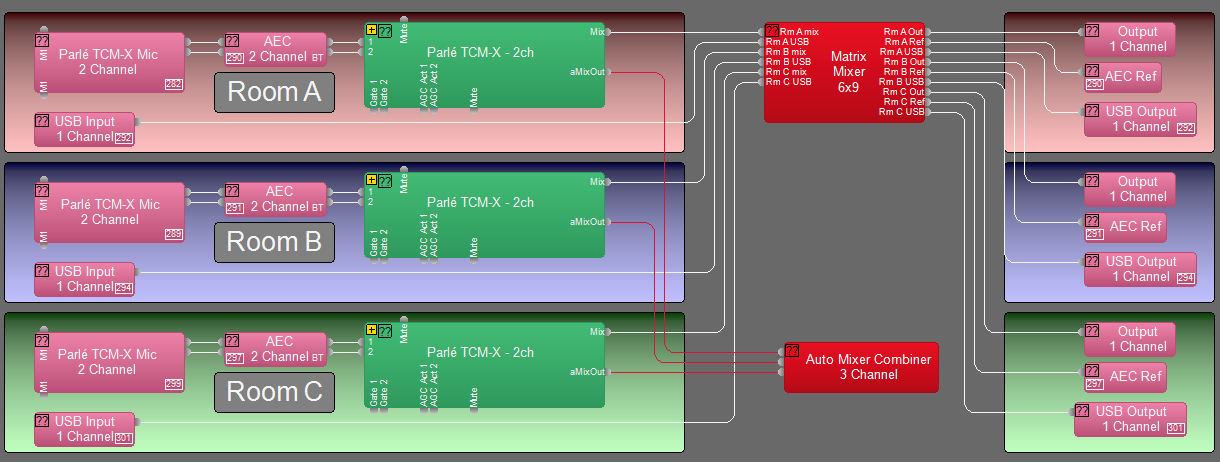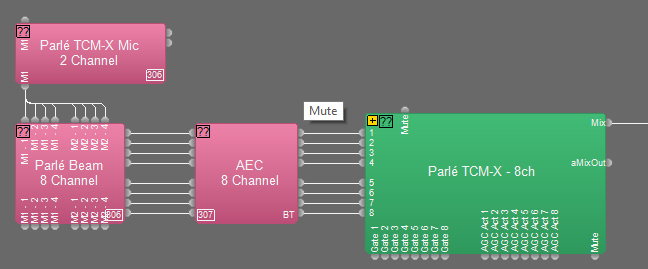Parlé Custom Processing Catalog
The Parlé Processing Block (introduced in Tesira software version 3.14) should be used with all Parle mic models whenever possible, but there are two specific use cases that are not supported by the Parlé Processing Block: the Auto-Mixer Combiner Block and Individual Beam Outputs. For these applications, we have provided a Custom Processing Library to import into Tesira software that provides the same signal flow processing as the Parlé Processing block.
The custom library blocks are set to match the default Good Room Acoustics Settings of the Parlé Processing Block and can be adjusted as needed.
The two specific use cases for are described below:
Auto Mixer Combiner Block
The Auto Mixer Combiner blocks is a special block in Tesira that contains additional "behind the scenes" links to the connected Auto Mixer blocks. The combiner block allows you to link multiple auto mixers so they function as a single unit. When auto mixers are combined, the gating information, last mic hold, and open mic limits are shared across blocks. In order to associate this link, you connect the mix (M) output of the auto mixer to the Auto Mixer Combiner block.
The Parlé Processing block contains additional processing between the mix output of the auto mixer and the output of the block, so a connection to a combiner block will not properly link control data between blocks. The custom processing processing catalog contains custom blocks that provide access to this link when utilization of the combiner blocks is needed.
Individual Beam Outputs
The Parlé Processing Block does not support connections to the individual beam outputs when that option is enabled on the microphone. When using this feature, you must provide the proper processing separately. The custom blocks available in the Parlé Custom Processing Catalog facilitate the use of this feature when needed.
Individual beam outputs are not available on the TCM-1, TCM-1A, or TCM-1EX models.
Importing the New Parlé Custom Processing Catalog
Download the Parlé Custom Processing Catalog file from this link:
New Parlé Custom Processing Catalog v1-0.tlf (use v1.0 for Tesira versions 3.14 and 3.15)
New Parlé Custom Processing Catalog v2.0.tlf (use v2.0 for Tesira versions 3.16 and later)
If the Tesira Processing Library docking window is not visible, enable it by clicking on the library icon and make it visible by selecting the Processing Library tab. The position of the docking windows can be customized and may not appear in the same location as show below.

To import the library file into your installation of Tesira software, select the import icon in the Processing Library toolbar and then navigate to the file location to select the file.

Once the library has been successfully imported, you can click on the appropriate custom block in the Items list and drag it into your layout. Blocks are included for the TCM-1, TCM-X, and TTM-X microphones in channel counts ranging from one to eight.
Using Parlé microphones with the Auto Mixer Combiner block
The blocks included in the catalog include a direct path from the auto mixer mix output labeled aMixOut. This path bypasses the AGC, summing mixer, output compression, and mute blocks and allows the necessary back channel communication between the combiner block and the auto mixer blocks.

Below is an example of a room that is divisible into three sections. For this application, you would use presets to recall the different room combinations and include the Matrix Mixer and Auto Mixer Combiner in the preset.

Please refer to the online Tesira help for more information regarding the Auto Mixer Combiner and presets.
Room Combiner Block
Tesira contains a Room Combiner Block that incorporates the functions of a matrix mixer, auto mixer combiner, and additional processing features. Connecting the aMixOut from the custom block will bypasses critical signal processing. It is recommended that you use a combination of the Auto Mixer Combiner and Matrix Mixer for most applications. It is possible to use both the Room Combiner block and the Auto Mixer Combiner blocks in tandem if it is necessary to utilize the additional features of the Room Combiner block.
Using Parlé microphones with beam outputs
Individual beam outputs are not available on the TCM-1, TCM-1A, or TCM-1EX models.
The TCM-X and TTM-X series microphone arrays contain four microphone beams that detect and follow talkers in the room. Each beam covers a 90-degree area of the overall coverage pattern. Typically, these four beams are summed together into a single audio signal through a built-in gain sharing auto mixer. There are some applications where the system designer may prefer to use the individual beams for more granular signal routing or other purposes such as using a gating auto mixer instead of the gain sharing auto mixer. Another possibility might be to individually track which beams are gated on and then use logic to feed a control system that provides camera tracking.
The Parlé Processing Block does not allow you to connect individual beams, so you must perform the required signal processing in your design. The blocks included in the Parlé Custom Processing library provide the same signal processing blocks that are included within the Parlé Processing Block and allow you to use the individual beam outputs of the Parlé microphone input block.
Below is an example of a simple design file using a TCM-X microphone with an additional TCM-XEX for a total of two microphone arrays. With this case, there will be a total of eight microphone beams that must be processed and mixed using the 8-channel custom block.

Please refer to Parlé microphone - individual beam outputs for additional information on the use of of the beam outputs block.

